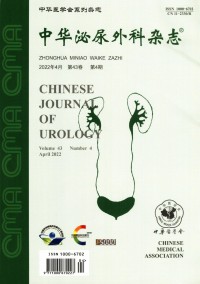The anatomical structure of fused renal pyramid and its imaging findings in ultrasound and computed tomography
Q4 Medicine
引用次数: 0
Abstract
Objective To analyze the anatomical structure and distribution of the fused renal pyramid (FRP) in cadaveric kidney, and discuss its appearances by CT and ultrasonic examinations. Methods From June 2018 to September 2018, 108 cadaveric kidneys were proceeded for regional anatomy. The distribution and anatomical manifestations of FRP was recorded. The renal pyramid was sliced and HE stained to explore the vascular distribution in FRP. From October 2018 to January 2019, ultrasound imaging data of 112 patients with 224 kidneys were collected, including 60 males and 52 females, age (39.0±15.1), ranging from 16 to 73 years old. The renal imaging data of 89 patients and 178 patients with enhanced renal CT were collected, including 48 males and 41 females. Age (45.4±13.6), ranging from 23 to 69 years old. The imaging findings of FRP in ultrasound and enhanced CT was summarized. Results In cadaver kidneys, the proportion of FRP in upper and lower calyces was 68.6% (74/108) and 64.8% (70/108), respectively, higher than that in middle calyces 34.3% (37/108). In the middle group, the incidence of mild fusion was 39.0% (16/41) and severe fusion was 48.8% (20/41). The incidence of fusion of two renal pyramidal structures was 90.2% (37/41). HE staining showed that the boundary between the artery in FRP and the surrounding renal pyramidal was unclear, and the protection of connective tissue was lacking. In Ultrasound, the FRP presented as a large trapezoidal hypo-echoic area with red and blue color signals in doppler mode. In ultrasound, the incidence of FRP was 18.8% (42/224). In enhanced CT, the FRP presented as enhanced cord-like high density shade in large low density area in cortex phase. In enhanced CT, the incidence of FRP 27.5%(49/178). Conclusions The FRP is a common structure in human kidney. The arteries localize within the FRP and are absence of sufficient connective tissue protection which are different from normal arteries. Ultrasound and enhanced CT have recognition ability for FRP. Key words: Kidney diseases; Fused renal pyramid; Anatomical structure; Percutaneous nephrolithotomy; Ultrasound; Computed tomography融合肾锥体的解剖结构及其在超声和计算机断层扫描中的影像学表现
目的分析尸体肾脏融合肾锥(FRP)的解剖结构和分布,探讨其CT和超声表现。方法从2018年6月至2018年9月,对108具尸体肾脏进行区域解剖。记录FRP的分布和解剖表现。肾锥体切片,HE染色,观察纤维增强塑料内的血管分布。从2018年10月到2019年1月,收集了112名患者的超声成像数据,共224个肾脏,其中男性60人,女性52人,年龄(39.0±15.1),年龄从16岁到73岁不等。收集了89例患者和178例肾CT增强患者的肾脏影像学数据,其中男性48例,女性41例。年龄(45.4±13.6),23~69岁。总结了FRP在超声和增强CT中的影像学表现。结果在尸体肾脏中,上肾盏和下肾盏FRP的比例分别为68.6%(74/108)和64.8%(70/108),高于中肾盏的34.3%(37/108)。在中间组中,轻度融合的发生率为39.0%(16/41),重度融合的发病率为48.8%(20/41)。两个肾锥体结构融合的发生率为90.2%(37/41)。HE染色显示FRP内动脉与周围肾锥体的边界不清楚,缺乏结缔组织的保护。在超声中,FRP表现为一个巨大的梯形低回声区,在多普勒模式下有红色和蓝色信号。在超声检查中,FRP的发生率为18.8%(42/224)。在增强CT中,FRP表现为皮质期大面积低密度区增强的索状高密度阴影。在增强CT中,FRP的发生率为27.5%(49/178)。结论FRP是人类肾脏中常见的结构。动脉位于FRP内,缺乏足够的结缔组织保护,这与正常动脉不同。超声和增强CT对FRP具有识别能力。关键词:肾脏疾病;融合肾锥体;解剖结构;经皮肾取石术;超声;计算机断层扫描
本文章由计算机程序翻译,如有差异,请以英文原文为准。
求助全文
约1分钟内获得全文
求助全文
来源期刊

中华泌尿外科杂志
Medicine-Nephrology
CiteScore
0.10
自引率
0.00%
发文量
14180
期刊介绍:
Chinese Journal of Urology (monthly) was founded in 1980. It is a publicly issued academic journal supervised by the China Association for Science and Technology and sponsored by the Chinese Medical Association. It mainly publishes original research papers, reviews and comments in this field. This journal mainly reports on the latest scientific research results and clinical diagnosis and treatment experience in the professional field of urology at home and abroad, as well as basic theoretical research results closely related to clinical practice.
The journal has columns such as treatises, abstracts of treatises, experimental studies, case reports, experience exchanges, reviews, reviews, lectures, etc.
Chinese Journal of Urology has been included in well-known databases such as Peking University Journal (Chinese Journal of Humanities and Social Sciences), CSCD Chinese Science Citation Database Source Journal (including extended version), and also included in American Chemical Abstracts (CA). The journal has been rated as a quality journal by the Association for Science and Technology and as an excellent journal by the Chinese Medical Association.
 求助内容:
求助内容: 应助结果提醒方式:
应助结果提醒方式:


